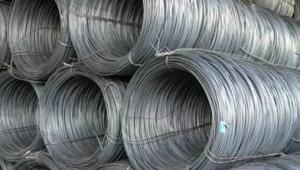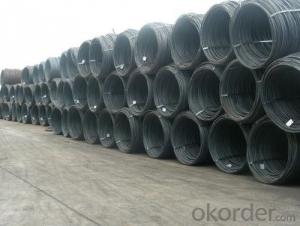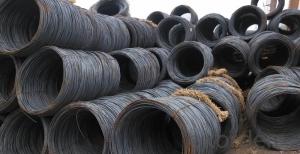Hot Rolled Steel Wire Rod with Good Quality with The Size 10mm
- Loading Port:
- Tianjin
- Payment Terms:
- TT OR LC
- Min Order Qty:
- 50 m.t.
- Supply Capability:
- 20000 m.t./month
OKorder Service Pledge
OKorder Financial Service
You Might Also Like
Hot Rolled Steel Wire Rod with Good Quality with The Size 10mm
Application: Carbon steel wire rod is widely used in construction and manufacturing. Carbon steel wire rod is mainly used for reinforcement of reinforced concrete and welded structure or reprocessed (roberts , nail, etc.) materials, especially used to produce wire drawing, welding electrode, nails, spring, electronic, precise machinery parts and so on.
Features:
Different Sizes: 5.5mm---16mm
Different Material Grade:SAE1006 SAE1008 SAE1010 SAE1012 etc
Packaging & Delivery of Wire Rod SAE1008B:
Packaging Detail: products are packed in coil and then shipped by container or bulk vessel
Each coil weight: 2-3MT
Delivery Detail: within 45 days after received deposit or LC.
Label: to be specified by customer, generally, each bundle has 1-2 labels

- Q: What are the requirements for steel wire rod used in cable-stayed bridge wire strands?
- The stringent nature of the requirements for steel wire rod used in cable-stayed bridge wire strands stems from the critical role these components play in ensuring the safety and structural integrity of the bridge. Below are some key requirements for steel wire rod used in cable-stayed bridge wire strands: 1. Composition of Material: The steel wire rod must be crafted from high-quality, high-strength steel with specific chemical composition requirements. This is necessary to guarantee the wire's ability to withstand the loads and stresses it will encounter in the cable-stayed bridge. 2. Tensile Strength: The wire rod must possess a minimum tensile strength that fulfills the design requirements of the cable-stayed bridge. This ensures that it can endure the tension forces exerted on it without deformation or failure. 3. Ductility: The steel wire rod must possess adequate ductility to allow for bending and shaping without fracturing or losing its strength properties. This is crucial during the fabrication and installation processes of the wire strands. 4. Uniformity and Consistency: The wire rod should exhibit uniform and consistent material properties throughout its length. This is essential to ensure consistent performance and behavior of the wire strands under various loading conditions. 5. Surface Quality: The surface of the wire rod should be smooth and devoid of defects such as cracks, scratches, or other surface irregularities. This is necessary to prevent stress concentration points or potential initiation sites for failure. 6. Dimensional Accuracy: The wire rod should adhere to specific dimensional tolerances to ensure proper fit and compatibility with the cable-stayed bridge design. This includes requirements for diameter, roundness, and straightness. 7. Resistance to Corrosion: The wire rod must possess effective corrosion resistance properties to withstand exposure to environmental conditions, including moisture, humidity, and chemicals. This contributes to the wire strands' long-term durability and safety. 8. Certification and Testing: The steel wire rod used in cable-stayed bridge wire strands must be manufactured by reputable producers and should be accompanied by relevant certifications and test reports. These documents offer assurance that the wire rod meets the specified requirements and has undergone necessary quality control measures. It is important to note that project-specific requirements and design standards may vary, and the above requirements may not cover all aspects. Consulting the applicable design codes and specifications for cable-stayed bridges is crucial to ensure compliance with the project-specific requirements.
- Q: How is steel wire rod different from other types of steel products?
- Steel wire rod is different from other types of steel products because it is a semi-finished product that is primarily used for further processing into various steel wire and steel wire products. Unlike other steel products, such as bars or sheets, steel wire rod is typically hot-rolled and has a round cross-section. Its specific composition and mechanical properties are tailored to meet the requirements of wire drawing, making it suitable for manufacturing a wide range of wire-based products, such as nails, wires, cables, springs, and reinforcement materials.
- Q: What are the common production processes for oxygen-coated steel wire rod?
- The common production processes for oxygen-coated steel wire rod include cleaning and descaling the steel wire rod, applying a thin layer of oxygen coating through a high-speed mechanical process, and then curing the coating through heat treatment.
- Q: What are the factors that affect the corrosion resistance of steel wire rod?
- There are several factors that can affect the corrosion resistance of steel wire rod. Firstly, the composition of the steel is a significant factor. Different alloying elements can alter the corrosion resistance of steel wire rod. For example, the addition of chromium and nickel in stainless steel enhances its resistance to corrosion. Secondly, the surface condition of the steel wire rod plays a crucial role. If the surface is rough or contains impurities, it can provide sites for corrosion initiation. In contrast, a smooth and clean surface can inhibit corrosion. Thirdly, environmental conditions can greatly impact the corrosion resistance of steel wire rod. Factors such as humidity, temperature, and the presence of corrosive substances like acids or salts can accelerate corrosion. Exposure to marine environments or industrial atmospheres with high levels of pollutants can also increase the likelihood of corrosion. Furthermore, the protective coatings applied to steel wire rod can greatly enhance its corrosion resistance. Coatings like zinc or epoxy can act as a barrier against corrosive agents, preventing them from reaching the surface of the steel. Lastly, the presence of mechanical stress or strain can influence the corrosion resistance of steel wire rod. Stress concentrations or deformation can create microcracks or expose vulnerable areas, leading to localized corrosion. In conclusion, the corrosion resistance of steel wire rod is influenced by factors such as alloy composition, surface condition, environmental conditions, protective coatings, and mechanical stress. Understanding and controlling these factors are crucial for ensuring the longevity and reliability of steel wire rod in various applications.
- Q: How is steel wire rod used in the manufacturing of wire rope fittings?
- Steel wire rod is used in the manufacturing of wire rope fittings as it serves as the primary material for creating the wire strands that form the core of the wire rope. The wire rod is shaped and formed into individual strands, which are then twisted together to create a strong and durable wire rope. These wire rope fittings are crucial components in various industries such as construction, mining, and transportation, where they provide reliable and secure connections for lifting and pulling heavy loads.
- Q: How is steel wire rod used in the manufacturing of electrical cables?
- Steel wire rod is used in the manufacturing of electrical cables as it provides strength and durability to the cables. It is typically used as the core or conductor of the cable to ensure efficient transmission of electricity. The steel wire rod is first drawn into thin wires, which are then twisted or braided together to form the cable's core. This core serves as a pathway for electrical current, and the steel composition enhances the cable's mechanical strength and resistance to stretching or breaking. Overall, steel wire rod plays a crucial role in ensuring the reliability and longevity of electrical cables.
- Q: What are the chemical properties of steel wire rod?
- The specific composition of steel wire rod can cause variations in its chemical properties. Generally, steel wire rod consists mainly of iron and carbon, with small amounts of manganese, silicon, and sulfur. The properties of steel wire rod are greatly influenced by its carbon content. Low carbon steel wire rod, which contains less than 0.25% carbon, is known for its ability to be formed easily and its ductility. This type of steel is commonly used in applications where flexibility and malleability are important, such as in the production of wire products, nails, and screws. On the other hand, high carbon steel wire rod, which contains between 0.60% and 0.85% carbon, is characterized by its strength and hardness. This type of steel is often used in applications that require high tensile strength and resistance to wear, such as in the production of springs, cables, and piano wires. Manganese is another element that can be found in steel wire rod. It is added to enhance the strength and hardenability of the steel. Manganese also improves the steel's resistance to corrosion and promotes the formation of a fine-grained microstructure, which contributes to its overall toughness. Silicon is commonly present in steel wire rod as a deoxidizing agent. It helps eliminate impurities from the steel during the manufacturing process and enhances its ability to withstand high temperatures without undergoing deformation. Sulfur is a trace element that is typically regulated during the production of steel wire rod. Its presence can negatively affect the steel's ductility and toughness. Therefore, it is usually kept at low levels to ensure the desired mechanical properties of the wire rod. In conclusion, the chemical properties of steel wire rod are determined by its composition, with the carbon content being the most significant factor. Other elements, such as manganese, silicon, and sulfur, are also present in varying quantities and contribute to the steel's strength, hardness, ductility, and corrosion resistance.
- Q: How is steel wire rod tested for internal defects?
- Steel wire rod is commonly tested for internal defects through a method known as non-destructive testing (NDT). There are various NDT techniques used to identify and evaluate internal defects in steel wire rod. One of the frequently employed methods is ultrasonic testing (UT), which involves the use of high-frequency sound waves to detect internal flaws. A transducer emits ultrasonic waves into the wire rod, and the waves are reflected back when they encounter any internal defects. These reflected waves are then analyzed to determine the size, shape, and location of the defects. Another method that can be used is eddy current testing (ECT). ECT utilizes electromagnetic induction to detect surface and near-surface defects in the wire rod. A coil carrying an alternating current is passed over the wire rod, and any fluctuations in the electrical conductivity caused by defects are detected. This technique is particularly effective for detecting cracks and other surface-related flaws. Magnetic particle testing (MPT) is another commonly used method. It involves magnetizing the wire rod and then applying iron particles to its surface. These particles will gather around the areas where there are internal defects, making them visible to the inspector. Additionally, dye penetrant testing (DPT) can be employed to identify surface-breaking defects in the wire rod. This method involves applying a liquid dye to the surface of the rod, which penetrates into any cracks or openings. After a certain time period, the excess dye is removed, and a developer is applied to make the defects visible. In conclusion, steel wire rod is tested for internal defects through non-destructive testing methods such as ultrasonic testing, eddy current testing, magnetic particle testing, and dye penetrant testing. These techniques allow for the identification and evaluation of internal flaws without damaging the wire rod.
- Q: What are the common production processes for uranium-coated steel wire rod?
- The common production processes for uranium-coated steel wire rod typically involve several steps. First, the steel wire rod is cleaned and prepared to remove any impurities. Then, a layer of uranium is deposited onto the surface of the wire rod through a process called electroplating or electro-deposition. This involves immersing the wire rod in a solution containing uranium ions, and using an electric current to attract and deposit the uranium onto the surface of the rod. Once the desired thickness of uranium coating is achieved, the wire rod is inspected for quality and undergoes further treatments, such as drying and curing, to ensure the adhesion and durability of the coating. Finally, the uranium-coated wire rod is ready for use in various applications, such as nuclear fuel production or other specialized industries.
- Q: What are the main trade associations and organizations in the steel wire rod industry?
- Some of the main trade associations and organizations in the steel wire rod industry include the American Wire Producers Association (AWPA), the Steel Wire Association of America (SWAA), and the International Wire and Machinery Association (IWMA). These associations play a significant role in promoting the interests of the industry, setting standards, fostering networking opportunities, and advocating for the steel wire rod sector at both national and international levels.
Send your message to us
Hot Rolled Steel Wire Rod with Good Quality with The Size 10mm
- Loading Port:
- Tianjin
- Payment Terms:
- TT OR LC
- Min Order Qty:
- 50 m.t.
- Supply Capability:
- 20000 m.t./month
OKorder Service Pledge
OKorder Financial Service
Similar products
Hot products
Hot Searches
Related keywords




























